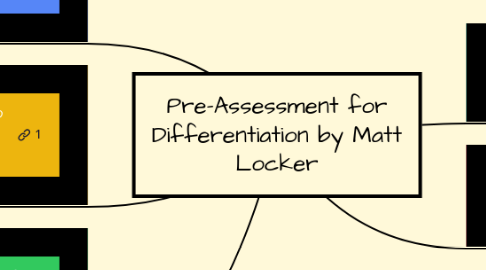
1. The 5 students (or top 20%) who answered most, including the most difficult, of the pre-assessment questions correctly
1.1. Strategies
1.1.1. Students will brainstorm real life problems that we have seen happen in school or on the way to and from school and students describe what senses they would use to stay safe. This group will create a public awareness campaign (communicating with the local transport companies) that informs the school community about the common problems and how the students can increase their awareness of staying safe using our senses. They will view and discuss the attached video
1.1.2. Student could use this resource to map out their campaign
1.1.3. It is also possible that these students can make a the public aware of a different topic, not neccessarily safety. After establishing student interests (i.e. do they wish to pursue the topic of Safety or research and present on another topic?) the students may undertake Independent Study
2. The 12 students (middle 60%) who have some knowledge about the topic as shown in their score, but need to develop higher order thinking skills
2.1. Strategies
2.1.1. These students will be split into two groups and will be given short answer questions on real-life problems they have observed. Before the assessment task, the students will brainstorm real life problems that they have seen happen in school or on the way to and from school and students describe what senses they use to stay safe. This group will be tasked with recounting an experience traveling to school, then offering possible solutions to the problems. They should write in an organized manner, using appropriate facts and relevant, descriptive details to support main idea. They should use the attached graphic organizer to help them.
3. The 5 students ( bottom 20%) who appear to have limited knowledge about the topic
3.1. Strategies
3.1.1. The main deficit for this group may be understanding English. These students will work cooperatively to further their understanding of basic safety premises. In order for them to progress to describe how they will use their senses to keep them safe, they first have to be able to understand basic safety concepts. The innovative strategy of cooperative learning sparks engagement in classrooms by encouraging interaction among the students themselves. The teacher, (and/or the Teaching Assistant) rather than calling on one student at a time, will review previous classes, in which we studied road signs and the 5 senses and will also provide the students with handouts and a glossary and will sit in with this group to develop their understanding. The teacher will use the KWL Chart attached to this box. The students will draw pictures of a situation where they have to use their senses to stay safe (one that we discussed or a new one with teacher approval). The students assessment product will be to produce a poster depicting 3 common safety issues and, if possible, 3 ways to prevent the issues.
3.1.2. These students (along with the TA) will review the glossary and translate it into Japanese..
4. Kahoot Pre-assessment Quiz.
5. References
5.1. References 5. Pre-assessment Ideas - Differentiation & LR Information for SAS Teachers. (2016). Sites.google.com. Retrieved 25 September 2016, from https://sites.google.com/site/lrtsas/differentiation/5-preassessment-ideas Bell, D. (2016). Exemplars - RTWS. Wku.edu. Retrieved 25 September 2016, from http://www.wku.edu/rtwsc/exemplars.php Educational Leadership:Getting Students to Mastery:Differentiation: It Starts with Pre-Assessment. (2016). Ascd.org. Retrieved 25 September 2016, from http://www.ascd.org/publications/educational_leadership/dec13/vol71/num04/Differentiation@_It_Starts_with_Pre-Assessment.aspx University, C. (2016). Assessing Prior Knowledge-Teaching Excellence & Educational Innovation - Carnegie Mellon University. Cmu.edu. Retrieved 25 September 2016, from https://www.cmu.edu/teaching/designteach/teach/priorknowledge.html
5.1.1. Text book, exercises 34, 35, 36, 37
